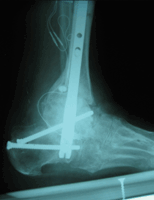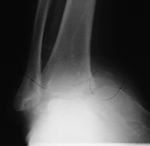Circular external fixation does not improve results of IM nail use in patients with Charcot neuropathy
The addition of circular external fixation does not affect the overall salvage or complication rate when dealing with type 3A Charcot stabilization with the use of a retrograde intramedullary nail, according to a recently presented study.
The findings were presented by J. George DeVries, DPM, AACFAS, at the 2010 Summer Meeting of the American Orthopaedic Foot and Ankle Society.
DeVries noted that not many studies have been done on the efficacy of combined internal and external fixation, saying it “has been reported fairly scarcely in the literature.”
The results, he reported, indicate that patients can be salvaged with the technique, but the high risk of complications makes it potentially less desirable as a treatment.
|
|
|
Images: DeVries JG |
The RAIN database
DeVries and his team pulled comprehensive chart and radiographic reviews of 52 patients with type 3A Charcot neuropathy who were treated with retrograde intramedullary nails with and without circular external fixation.
“We used the [retrograde arthrodesis intramedullary nail (RAIN)] database to compare those Charcot ankle patients who received the intramedullary nail only to those who received the intramedullary nail along with augmentative circular external fixation,” he said. “Our hypothesis was that the external fixator would increase salvage and union rates.”
|
|
Among the 52 patients, 45 were treated with a nail alone (Nail group) while seven were treated with circular external fixation augmentation (Xfix group). DeVries said his team used a primary end point of major amputation or braceable limb, with several variables evaluated for influence.
Study findings
“When we compared the results, we found that the groups were very similar with very few statistically significant differences,” DeVries said.
The researchers found chronic steroid use more often in the Xfix group, used in three patients (6.7%) in the Nail group and four (57.1%) in the Xfix group. Extended tarsal fusions were also more common in the Xfix group, DeVries said, and were required in six patients (13.3%) in the Nail group and three (42.9%) in the Xfix group
They also reported orthobiologic augmentation as being utilized in 28 patients (72.7%) in the Nail group and five (71.4%) in the Xfix group. Hardware removal, incision and drainage procedures, and intravenous antibiotics being required in 12 (42.2%), 22 (48.9%), and 25 (55.6%) patients, respectively, in the Nail group. The same comparisons across the Xfix group showed: three patients who needed hardware removal; three who needed incision and drainage procedures; and four who needed intravenous antibiotics.
Perhaps the most important result for the purposes of the study was the rate of major amputation in each group – 10 of 45 (22.2%) in the Nail group and 2 of 7 (28.6%) in the Xfix group.
The overall salvage rate, DeVries said, was 40 of 52 limbs (75.6%).
|
|
Similar salvage rates
“We feel that the external fixation may benefit patients who we label as high risk, but when we compared these patients to those who got the intramedullary nail only, we found there were similar salvage rates and complication rates,” DeVries said.
Though he and his team believe the added stability offered by external fixation could perhaps benefit patients who may be at high-risk for complications or require extended arthrodesis, DeVries noted that such a benefit could not be statistically proven within the study. – by Robert Press
Reference:
- DeVries JG, Berlet GC, Hyer C. Comparative analysis of Charcot ankle stabilization using an intramedullary rod with or without application of circular external fixation – utilization of the RAIN database. Presented at the 2010 Summer Meeting of the American Orthopaedic Foot and Ankle Society. July 8-10. National Harbor, Md.
- J. George DeVries, DPM, AACFAS, can be reached at skisnfeet@hotmail.com.
This article demonstrates that adding circular external fixation to a nail construct for Charcot ankle deformities does not necessarily improve outcomes. However, with the increased steroid use and adjunct fusions in the Xfix group, it may have decreased the risk of an even higher risk subgroup. Complication rates were similar in both groups, around 50% for hardware removal, incision and drainage, and antibiotic use, as was the amputation rate at around one-quarter of patients. Unfortunately, this study is small and retrospective with little statistical power to draw firm conclusions. Charcot ankle salvage remains a challenging task and any new information is helpful for choosing appropriate treatment and setting patient expectations.
– Daniel C. Farber, MD
Assistant Professor,
Foot and Ankle Orthopaedics
Chief, University Orthopaedics at
Kernan
Chief, Foot and Ankle Service, University of Maryland School of
Medicine
Department of Orthopaedics
Baltimore
The IM nail is being used frequently for difficult ankle arthrodesis as in the Charcot foot. Occasionally an external fixator has been added to IM nail cases to make greater assurance of fusion. In a structured study, DeVries and colleagues , who run a really good program, found there was no significant advantage to adding an external fixator to IM rod fixation for fusion.
In general, however, I think there would be very few people who would be adding a fixator to an IM nail.
– Ronald W. Smith, MD
Orthopedics Today
Editorial Board member
Long Beach, Calif.
![]() Follow
OrthoSuperSite.com on Twitter
Follow
OrthoSuperSite.com on Twitter





